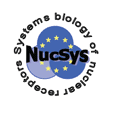 |
|
|||||
|
NucSys
Consortium Research Tasks Training and Transfer of Knowledge (ToK)
|
Research Tasks The Consortium will dissect multiple levels of NR action, from the regulation of chromatin architecture to tissue organization and physiome as outlined in the following five research tasks:
Systems Biology Modelling Vertical integration of NR signaling in cells up to tissue and whole organism function with the aim of capturing, comprehensively and mathematically, the dynamics of the NR network To date our understanding of NR actions has not allowed a predictive and preventive understanding. Therefore, the transition from a reductionist to an integrative, systems-biology approach will be required. Using this transition the consortium will model NR processes and describe the dynamic interaction between cellular components to identify critical nodes of control. Systems biology shares with cell physiology the characteristic that it tends to look at every function of the living cell at the same time. However, systems biology does this by relating the functions to the interactive properties of the molecules and is therewith holistic and reductionistic at the same time. To make this ambition manageable, this consortium has adapted the strategy to make inroads into the living cell by focusing on the NR family as it behaves somewhat as a semi-autonomous system. Experimentally determined interaction properties of the NR network will be combined with well-established physical chemical and molecular biological/genetic principles into mathematical models. The latter will then be a station in an asymptotic recursion between experiments and models until a validated model of the system in terms of interacting molecules has been arrived at. Models will be made for the physiological as well as for a number of pathological states. They will be analyzed in comparison and interrogated as to the effects of nutrients on aging-related diseases. Models and primary experimental data will be analyzed through a number of novel systems biology tools, including metabolic control analysis and hierarchical regulation analysis. The latter will indicate, how much of the response of the organism to compounds in the food is regulated through transcription control, how much through translation control and how much through metabolic control (and other control points). The former should enable to define control points that might serve as targets for therapy.
Genomics and Transcriptomics Define receptor complement in key tissues, establish shared and unique gene targets and assess presence and significance of NR target gene polymorphisms. This Consortium has expression profiled NRs and their gene targets via in silico and transcriptomic analysis in unique collections of knock-out (KO) mice and human normal and diseased material revealing the widespread expression of many NRs beyond their classical sites of action and supported the concept of tissue-specific transcriptomes (e.g., in bone or skin cells), regulated by the NR ligands 1,25-dihydroxyvitamin D3, retinoic acid, estradiol and glucocorticoids Further complexity is revealed through the functional clustering of response elements (REs) of the most responsive primary NR target genes, such as CYP24, CYP3A4 and CYP2B6 and the regulation of NRs by other transcription factors, such as the transrepressor SNAIL. Equally, NR and NR target gene polymorphisms have emerged as significant, e.g., in the control of aging-related bone mass loss and breast and colon cancer risk as well as in the onset of complications of the metabolic syndrome, such as obesity, type 2 diabetes and hypertension. Therefore, the Consortium will dissect the integrated transcriptional effects of NRs and establish the significance of polymorphic variance and tissue specificity.
Proteomics Research Task Define the constituents of NR-co-factor interactions in the context of the gene promoter and the cytoplasm. NR proteins have domains to facilitate interactions with other proteins, such as other receptors, CoAs and CoRs. Tissues may have a “programmed” sensitivity to NR action dependent on the expression levels of these co-factors. The potential importance of this level of regulation is highlighted by observations of disruption in diseaese e.g., in cancer, causing NR sensitivity. To define these interactions comprehensively the Consortium teams are using proteomic profiling using 2D-DIGE and mass spectrometry (MS) analyses of different human cells treated with NR ligands (e.g., bone, skin and different cancer cells) to reveal distinct NR, transcription factor, CoA and CoR profiles during differentiation. These techniques and others (MS, MS/MS analysis of the HPLC separated peptides and novel nano-LC/MS and nano-LC/MS-ft/MS) will be used to interrogate NR-triggered changes of the proteome.
Metabolomics Reveal key homeostatic NR-activating and inactivating metabolic marker and to what extent their regulation is disrupted in disease. Metabolic control of ligand availability is a finely tuned homeostatic feedback loop central to NR actions. This is disrupted through normal aging and associated diseases including metabolic syndrome (e.g., insulin resistance, obesity and cardiovascular disease), which has been described in terms of a systems-biology etiology. Equally an emerging area is the ability of NRs to stimulate metabolism of xenobiotics, including therapeutic drugs, by inducing a roster of CYP enzymes to provide tissue protection, which when attenuated results in genotoxic insult. The Consortium will therefore integrate these metabolomic approaches with others, to understand NR function.
Physiomics Design model human tissue systems and murine models to reveal the impact of the ‘life-time’ exposure to dietary factors. Many tissues, in which NRs function, are also critical sites of self-renewal, such as the skeleton and epithelial structures. Moreover, imbalances in NR actions contribute to osteoporosis and have been identified as risk factors for colorectal and breast cancer. Equally, NRs improve function and regulate differentiation and self-renewal, e.g., in bone and skin, the lining of the gastrointestinal tract and the ductal structure of the prostate and mammary glands in both chemoprevention and skin anti-aging treatment. Similarly, endocrine disrupters, which target NRs, have become increasingly recognized as a significant threat to human health. Using tissue and murine expertise the Consortium will model and demonstrate long-term aspects of NR signaling and confirm the significance of nodal points identified through systems biology modelling. |
|||||
NucSys: Systems biology of nuclear receptors: A nutrigenomic approach to aging-related diseases |
